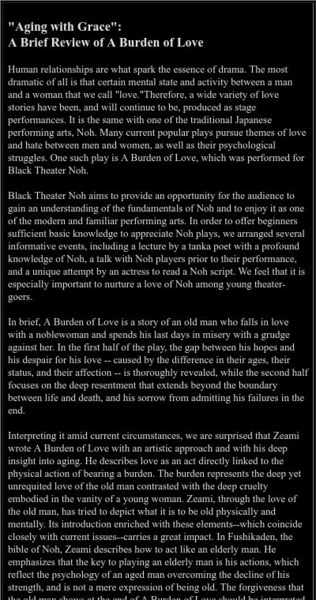Other
Oriland: What Origami Can Be!
Resource all about origami, the Japanese art of paper folding, with many examples, links, and resources. Features videos and instructional diagrams.
Curated OER
Clip Art by Phillip Martin: Japanese Tea Ceremony
Digital cartoon of a woman performing a traditional Japanese tea ceremony.
John F. Kennedy Center
The Kennedy Center: Oceans: A Sensory Haiku
In this lesson plan, students use the ocean and their five senses as inspirations to create their own unique haikus. Lesson provides assessment criteria and a list of sources.
Other
Aichi Arts Center: Aging With Grace: A Brief Review of "A Burden of Love"
This site provides a review and summary of Zeami's noh drama, "A Burden of Love." The author includes details about how the noh performer would portray a part.
Brooklyn Museum
Brooklyn Museum: Hiroshige's One Hundred Famous Views of Edo
Explanatory notes and images from an online exhibition of nineteenth-century woodcuts by one of Japan's most-revered artists, Utagawa Hiroshige. "Hiroshige's One Hundred Famous Views of Edo" represents over 100 prints of scenes of Tokyo...
Other
Art Montana: Ben Steele Prisoner of War Chronicles
The story of Ben Steele, an American soldier captured on the Bataan Peninsula and forced on the Bataan Death March. The site links to his drawings with a brief explanation.
Other
The Japan Times Online: The World's Window on Japan
The Japan Times is a daily newspaper published in Tokyo, Japan. Content includes top national and international news, business coverage, the arts and society coverage, sports, events, and more.
CommonLit
Common Lit: Why I Love a Country That Once Betrayed Me
CommonLit.org is a wonderful resource to use in a Language Arts classroom. Each story or article is accompanied by guided reading questions, assessment questions, and discussion questions. In addition, students can click on words to see...
Other
Miho Museum: Landscape
See the collection of ancient and classical art from both eastern and western traditions, housed in the Miho Museum Museum of Japan, which was designed by I.M. Pei and features an integrated Japanese garden.
California State University
Origami
Learners of all ages love learning origami. This instructional activity gives good outlines on how to set up a classroom for this challenging, yet fun art form. There is a great suggestion to incorporate the picture book "Sadako and the...
Khan Academy
Khan Academy: Fresh Water Jar
This is a container to hold cold, fresh water made especially for use in the Japanese tea gathering. Its shape reminds us of a wooden bucket used to carry water from a well, but it is made out of porcelain, a glazed ceramic fired at a...
Khan Academy
Khan Academy: Tea Bowl With Dragon Roundels
This bowl was used for the tea ceremony. Learn when and how the Japanese people began to drink tea, what the dragon symbolizes, and who the artist is.
Khan Academy
Khan Academy: Archery Practice
This painting depicts one of several forms of archery practice formalized as early as the Kamakura period (1185-1333), this activity trained warriors to shoot accurately at moving targets while riding at a full gallop. View this picture...
Khan Academy
Khan Academy: Todai Ji
When completed in the 740s, Todai-ji (or "Great Eastern Temple") was the largest building project ever on Japanese soil. Its creation reflects the complex intermingling of Buddhism and politics in early Japan. View pictures and read...
Khan Academy
Khan Academy: Short Sword (Wakizashi) and Long Sword (Katana)
Sword making is a highly refined and respected art in Japan, part of a ritualized process requiring decades of training. View two examples and read the background of the importance of swords to the Japanese people.
Khan Academy
Khan Academy: Tea Bowl With Standing Crane Design (Gohon Tachizuru)
View a picture of a Japanese tea bowl and read about how it was used in tea gatherings during the Muromachi period.
Khan Academy
Khan Academy: Fresh Water Jar
This vessel is a container to hold cold, freshwater made especially for use in the Japanese tea gathering during the Muromachi period. View a picture of this jar and read about the details in this essay.
Khan Academy
Khan Academy: Scenes From the Tale of Genji
This pair of screens illustrates scenes from four chapters of Japan's classic literary work, "The Tale of Genji," written by a female courtier by the name of Murasaki Shikibu in around the tenth-eleventh centuries. It is a romantic novel...
Khan Academy
Khan Academy: Arrival of a Portuguese Ship
In 1543, three Portuguese travelers aboard a Chinese ship drifted ashore on Tanegashima, a small island near Kyushu. They were the first Europeans to visit Japan. In 1548, Francis Xavier, a Jesuit, arrived from Goa to introduce...
Japanese Ministry of Foreign Affairs
Web Japan: Culture
Japanese traditional culture and modern culture are explored in this article from the Japanese Ministry of Foreign Affairs. Learn about the many traditional ceremonies and arts that are a part of Japanese culture.
Other
Asiaart: Japanese Ceramics
At this page from Asiaart, 5/6 of the way down is a description of Otagaki Rengetsu's work.
Alabama Learning Exchange
Alex: Origami Geometry
Origami (ori-folding, kami-paper) is the traditional Japanese art of folding paper. Students will discover relationships between shapes as they are actively engaged in this hands on geometry lesson to learn basic geometric shapes, their...
Curated OER
Clip Art by Phillip Martin: Japanese Girl: Illustration
Cartoon illustration of a Japanese girl wearing traditional attire.
Curated OER
Heilbrunn Zen Buddhism: Sculpture of a Zen Priest
Portrait of a Zen master, Japanese, fourteenth-fifteenth century.
Other popular searches
- Japanese Art and Music
- Japanese Art Criticism
- Japanese Art Activities
- Japanese Art for Children
- Heritage Japanese Art
- Japanese Art Project
- Japanese Art Lessons
- Japanese Art Paintings
- Hiroshtige Japanese Art
- Japanese Internment Articles
- Japanese Art Lesson Plans
- Art Japanese Calligraphy



















